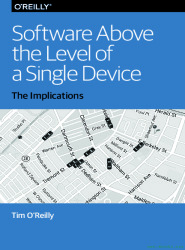Software Above the Level of a Single Device
In one striking example, O'Reilly cites Uber, the app-based taxi service that Aaron Levie of Box.net called "a $3.5 billion lesson in building for how the world should work instead of optimizing for how the world does work." Once cab drivers and potential passengers had devices reporting their location in real time, it became possible to rethink urban transportation.
Similarly, O'Reilly notes, when GE designs jet engines that report when they need maintenance, the notion of the "maintenance schedule" goes out the window. Manufacturing, logistics, transportation, healthcare are all ripe for the "Solid revolution." That revolution isn't just about designing smart stuff, and dumb stuff that can be built with smart tools, it's about designing software and systems above the level of a single device, software that completely transforms industries.
Download this report and learn why it's time for the most prodigious feats of imagination - applying hardware, software, big data, sociology, and creativity to redesign processes and institutions, not just things.
Table of contents
- Software Above the Level of a Single Device: The Implications
- Multiple Smart Things
- Importance of Human Input
- Implicit Versus Explicit Input
- Types of Sensors
- The System as a User Interface
- A Network of Devices
- The Robustness Principle
- Software Above the Level of a Single Device
- System of Interaction
- How the World "Should" Work
- Think About Things That Seem Hard
| Pages : | 18 |
| Size : | 5.0 MB |
| File type : | |
| Downloads: | 71 |
| Created: | 2022-02-03 |
| License: | CC BY |
| Author(s): | Tim O'Reilly |

Warning: Trying to access array offset on false in /home/tutovnfz/public_html/article.php on line 233
Others Computer science Tutorials
Others related eBooks about Software Above the Level of a Single Device
MATLAB IntroductionThis tutorial provides a small overview about Matlab by Stephan Roth ,training PDF courses to learn the basics of MATLAB programming designated to beginners....
Learning SASDownload free course Learning SAS, pdf file on 33 pages by Stack Overflow Community....
Azure Tips and TricksDownload free course Azure Tips and Tricks, pdf file on 67 pages by by Michael Crump....
Migrating Big Data Analytics into the CloudDownload free course Migrating Big Data Analytics into the Cloud, pdf file on 16 pages by Mike Barlow....
New Applications of Artificial IntelligenceThis book has a complete set of applications of artificial neural networks that allow the reader to gain experience about the new systems for implementing and developing artificial intelligence (AI) methods, which can run in several digital systems. On the other hand, the book shows the newest alg...
Category Theory for ProgrammersCategory Theory is one of the most abstract branches of mathematics. It is usually taught ..., download free Category Theory tutorial in PDF (498 pages) created by Bartosz Milewski ....
GNU GREP and RIPGREPDownload free course GNU GREP and RIPGREP, pdf file on 111 pages by Sundeep Agarwal....
Migrating to Cloud-Native Application ArchitecturesDownload free course Migrating to Cloud-Native Application Architectures, pdf file on 58 pages by Matt Stine....
Sensor TechnologiesDownload free course Sensor Technologies, pdf file on 321 pages by Michael J. McGrath, Cliodhna Ní Scanaill....
Elements of RoboticsDownload free course Elements of Robotics, pdf file on 311 pages by Mordechai Ben-Ari, Francesco Mondada....